

0


0
ART AND CULTURE
By Banani
16 October, 2016

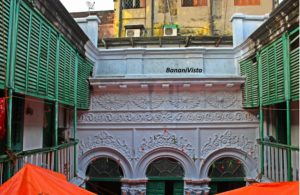 Nilmani Sen's heritage home
Nilmani Sen's heritage home
The History behind the legacy: Having said that I would like to introduce an ancestral home in central Kolkata commonly known as "Nilmani Sen Baari" where I met Parthasarathi Sen, who is actively keeping their heritage alive. This home is named after late Sri Nilmani Sen who was a gold merchant by profession. During the 19th century, he moved to Kolkata from Jessore, south-western region of Bangladesh and started living in Jakeria Street near Central Kolkata. It was then Sri Nilmani Sen started organizing Durga Puja in his Jakeria house premises. However, his grandson Sri Kanailal Sen acquired a house with thakur dalan addressed 130, Baithakkhana Road, where Nilmani Sen family celebrates Durga Puja at current times.
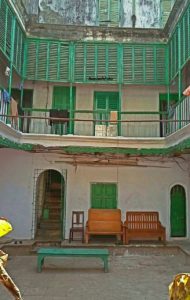 The courtyard
The courtyard
Sri Kanailal Sen's daughter Ratnamala Debi played an eminent role in the continuity of this family tradition after her father's departure. In the year, 1968, Sri Singharam Sen, the youngest son of Kanailal Sen took the main responsibility of worshipping Goddess Durga in the premises which were later followed by his son Sri Samir Kumar Sen since 1987.
During the year of centenary, in 2012, Sri Samir Kumar Sen’s soul decided to leave his body and thereafter his wife Smt. Purnima Sen along with his son, Parthasarathi Sen, and daughter in law, Mrs. Ashimita Sen continued to keep the legacy alive.
The Uniqueness of the Durga Idol: Unlike other idols which showcase Goddess Durga with ten hands features slaying the buffalo-demon "Mahisasura", Nilmani Sen family worship the idol which depicts peace and majesty- Abhaya Murti (having two arms in the form of fear not and benediction sitting on a throne of red lotus). A lion cub is the carrier of Goddess Durga.
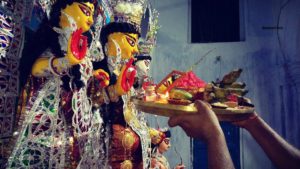 Offerings to Goddess Durga
Offerings to Goddess Durga
Puja Preparation: The onset of puja Preparation in Nilmani Sen’s home happens on the day of "Rath Yatra" during the month of June-July (Ashad month as per Bengali calendar).
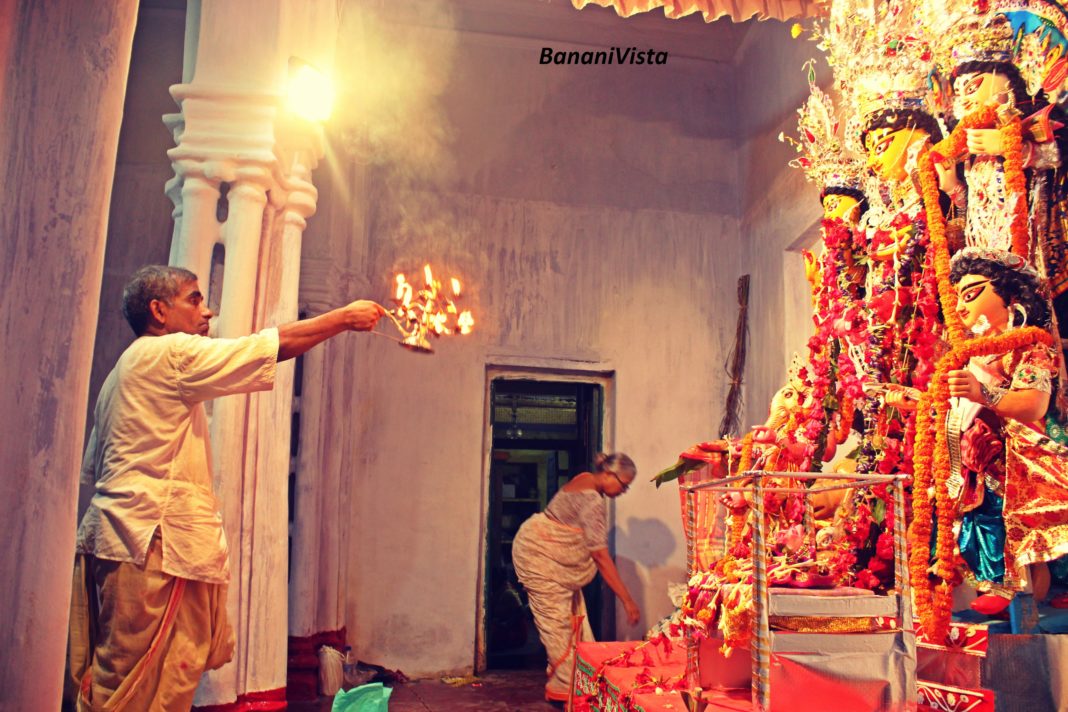
The celebration comprises of various rituals starting from Bodhon/Jagoran(marks the starting of Durga puja), Adhibas (Goddess is offered by the essentials of our lives which we acknowledge with gratitude and offer her cosmetics to beautify her).
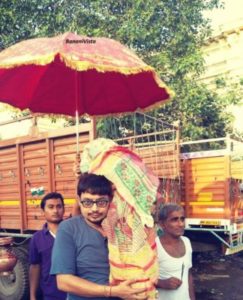
Nabapatrika binding (leaves of 9 different plants, viz, Banana leaf, Colocasia plant leaf, Turmeric plant leaf, Jayanti leaf, Applewood leaf, Pomegranate leaf, Ashoka leaf, Mankachu leaf and Paddy leaf) is of vital importance and represents Goddess Durga, Nabapatrika snan ( the binding will be taken to the banks of river Ganga followed by chanting of mantras, bathing of each Nabapatrika Devi and the ritual is closed by covering the binding of the leaves with Sari and taken back home provided shade by a big umbrella.
Mahasnan (a mirror is placed in a big bowl allowing the image of Goddess Durga reflects on it).
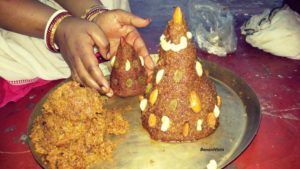 The Sweets
The Sweets
Pratima Pratistha (bringing life to the idol, ritual performed by holding a flower on the position of the heart of Goddess Durga followed by chanting the relevant mantras), Chakshurdan (ritual of activating the three eyes of the Goddess by taking a dry grass and putting the oily black shoot on its tip), Shorashopachareye puja (deals with offering with 16 items, few are cloth, sandalwood, lamp, flower, etc.), Sandhipuja and Sindoor Khela.
Sandhi Puja in Nilmani Sen’s family: Out of all the rituals, I would like to introduce the Sandhi Puja and Sindoor Khela in a detailed manner. As the name suggests, Sandhi Puja is performed in the evening, in between Ashtami (8th day) and Navami (9th day) for 48minutes. It covers the last 24minutes of Ashtami and first 24minutes of Nabami.
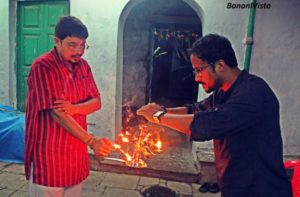
During Sandhi Puja, 108 lamps are lit in front of the Goddess; Pushpanjali is performed by offering flowers, Dhuno Purano, performed by the female members of the family followed by Havan and Chandipath (the complete book of Chandi is recited by the priest).
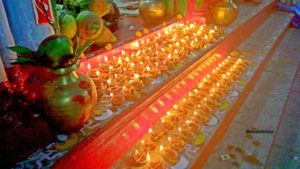 Shandhi
Shandhi
What sets Nilmani Sen's family apart is the ritual of Raktadan (offering of blood) which has been followed since centuries. Since this family doesn't allow the sacrifice of any living beings; hence the ritual is performed by offering blood from a small cut in the chest onto wood apple leaves and hibiscus flower.
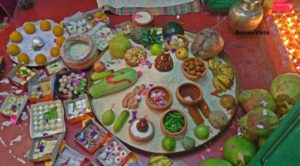
The immersion: After the grand celebration of nine days, the tenth day is the Vijaya Dashami Day, where the idols of Gods and Goddesses are immersed in water. Prior to that, Sindoor Khela is performed by married women by offering Sindoor (vermilion), sweets to Goddesses followed by smearing vermilion onto each other.
[video mp4="https://www.bananivista.com/uploads/2016/10/VID-20161015-WA0017.mp4"][/video]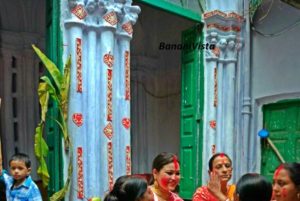 During the Sindoor Khela
During the Sindoor Khela
The daughter-in-law performed the entire ritual and I was glad to be a part of it.The idol is then taken to the shores of river.Ganga on a lorry with all the family members, neighbor on it.
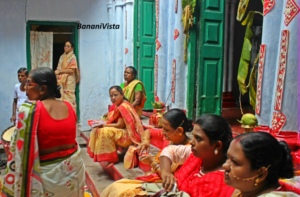

Kanakanjali: The ritual signifies provision of good wishes by Ma Durga
[video mp4="https://www.bananivista.com/uploads/2016/10/VID-20161015-WA0015.mp4"][/video]While taking the idols for immersion- on the lorry
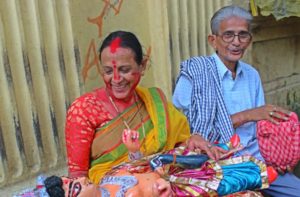
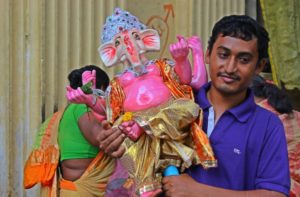
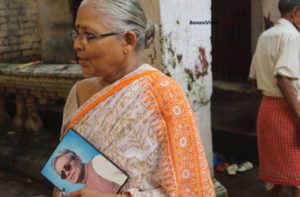
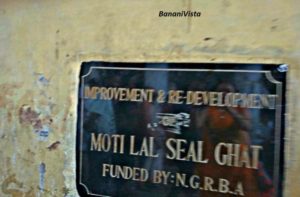
The drum beats continued till we reached the shore and back home. The high energetic sound woke up the city and made it conscious of the last ritual. The idols were dipped into the water with a chorus of "Jai Maa Durga".
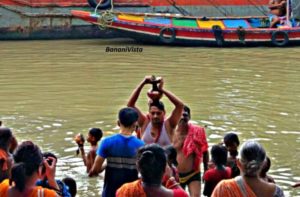
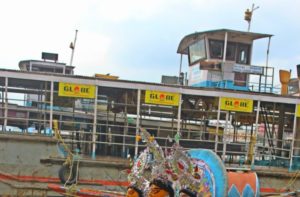
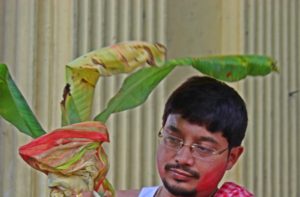
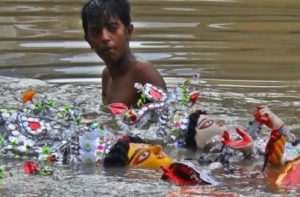
The Challenges:
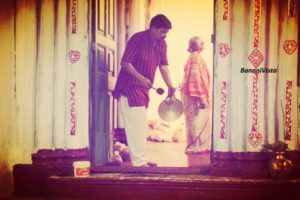
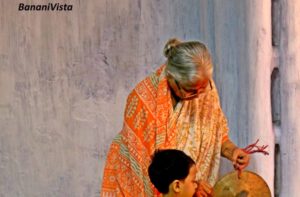
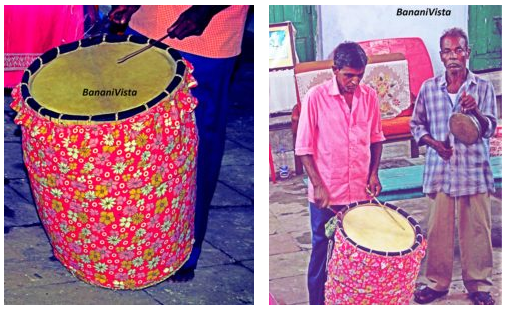 The most important people: The Dhakis
The Feast: After reaching home the whole family gather together to binge on delicious dishes, especially fish, curd, sweets in addition to rice, potato fry and mixed vegetable. The feast is a symbol of a happy ending, union of family members and of course, gratitude.
The most important people: The Dhakis
The Feast: After reaching home the whole family gather together to binge on delicious dishes, especially fish, curd, sweets in addition to rice, potato fry and mixed vegetable. The feast is a symbol of a happy ending, union of family members and of course, gratitude.
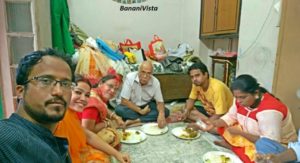 Note the address: 130 Baithakkhana road, Kolkata-700009
Contact Person: Parthasarathi Sen
Note the address: 130 Baithakkhana road, Kolkata-700009
Contact Person: Parthasarathi Sen